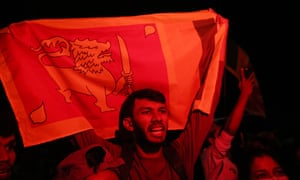by Charu Lata Hogg, The Guardian, UK, April 24, 2022
Severe shortages of fuel, food and medicine appear to have unified Sri Lankans against the ruling Rajapaksa family

Protesters outside the president’s office in Colombo, Sri Lanka, on Thursday. Photograph: Eranga Jayawardena/AP
Sri Lanka is facing an unprecedented political and economic emergency, a result of government mismanagement and the effect of global crises. But the tiny island nation is also seeing signs of cathartic revival. Despite longstanding ethnic, religious, linguistic and regional fault lines in Sri Lankan society, protesters have taken to the streets in unified resistance against the ruling Rajapaksa family, demanding a fix to spiralling food and energy costs.
After Sri Lanka emerged from decades of bloody civil war, it looked as if it would become one of Asia’s success stories, with growing industries and a burgeoning middle class. But today its rupee is the world’s worst performing currency, amid a crippling economic catastrophe compounded, in part, by the war in Ukraine.
The country has been financially mismanaged for years and would probably be in dire straits anyway. But an ill-advised sudden decision by the president, Gotabaya Rajapaksa, to ban all agricultural fertilisers in April 2021 has driven what were historically healthy crop yields through the floor, and further pushed up prices.

Sri Lanka: One dead and several wounded as police shoot protesters
Food inflation is running at 25%, overall inflation at some 18% – and the Russia-Ukraine war has seen diesel prices rise by 138% – all leading to what some politicians have said are “dangerous shortages” and the threat of starvation for its population of 22 million. A reliance on expensive food and energy imports is the last thing the cash-strapped nation needed against the backdrop of war in Europe.
With shortages, rolling power blackouts and nationwide protests, opposition parties are in the process of cautiously garnering support for the simple majority in parliament needed to bring a no-confidence motion against the government of Rajapaksa. A draft bill that seeks to reform the current governance system, including abolishing the executive presidency and passing on its powers to the prime minister, has been presented in parliament.
These are signs of hope, and offer the battered country a real chance to rebuild its republic and its destiny 50 years after it was formed. The pathways to building a pluralistic and economically stable society are still unclear, but Sri Lankans are demanding change at a pace not seen in previous years.
Three decades of ethnic conflict, which took the lives of 100,000 people, ended brutally with the defeat of the Liberation Tigers of Tamil Eelam in 2009, and chances of peace, reconciliation and equitable development vanished quickly afterwards. The victorious Rajapaksa dynasty, which rode a wave of ethno-nationalism in southern Sri Lanka, deepened the country’s ethnic divide, militarised the Tamil-dominated north and east, and took disastrous financial decisions.
This sparked a vote against them in 2015, punishing them for their perceived pillaging of the country and their dynastic rule. Mahinda Rajapaksa, who had intermittently served as prime minister and president of the country since 2004, was defeated. However, his brother Gotabaya contested, and won, the 2019 election. Having once kicked out the Rajapaksas, the electorate is now keen to not have them stay. This rejection appears to have also sparked a shift in the broad Sinhala – the island’s majority ethnic group – ethno-nationalism at play. Sajith Premadasa, the key opposition leader since 2019, has adopted a more inclusive, pluralistic stance in engaging with the Tamil community.
 In all the frenzied and seemingly cohesive upswell of public opinion, there are still some sobering facts: despite the massive unrest and deep unpopularity, Gotabaya and Mahinda continue to cling on to power tacitly, supported by the country’s military and police. Despite the optimism, there is a risk that the opposition may not succeed in hitting the simple majority it needs to oust the Rajapaksas, who in turn will deploy the military to quell the protests. All this will unfold against the backdrop of a rapidly developing humanitarian emergency with severe shortages of fuel, food and medicine.
In all the frenzied and seemingly cohesive upswell of public opinion, there are still some sobering facts: despite the massive unrest and deep unpopularity, Gotabaya and Mahinda continue to cling on to power tacitly, supported by the country’s military and police. Despite the optimism, there is a risk that the opposition may not succeed in hitting the simple majority it needs to oust the Rajapaksas, who in turn will deploy the military to quell the protests. All this will unfold against the backdrop of a rapidly developing humanitarian emergency with severe shortages of fuel, food and medicine.
In addition, last week the Sri Lankan government declared it would temporarily, and for the first time in its borrowing history, default on a foreign debt repayment. Sri Lanka suffers from a structurally weak economy and has suffered a massive reduction in trade and in government revenue. The nation currently owes some £27bn in international debts with less than £1.5bn reported in reserves. The World Bank has come to its rescue, but what is unarguably needed now is a slew of economic and political reform. The future remains very uncertain for Sri Lanka, and right now it needs its friends such as India, China and the EU to stand by it.
- Charu Lata Hogg is an associate fellow with the Asia Pacific programme, Chatham House and chair of the board of trustees of the Sri Lanka Campaign for Peace and Justice